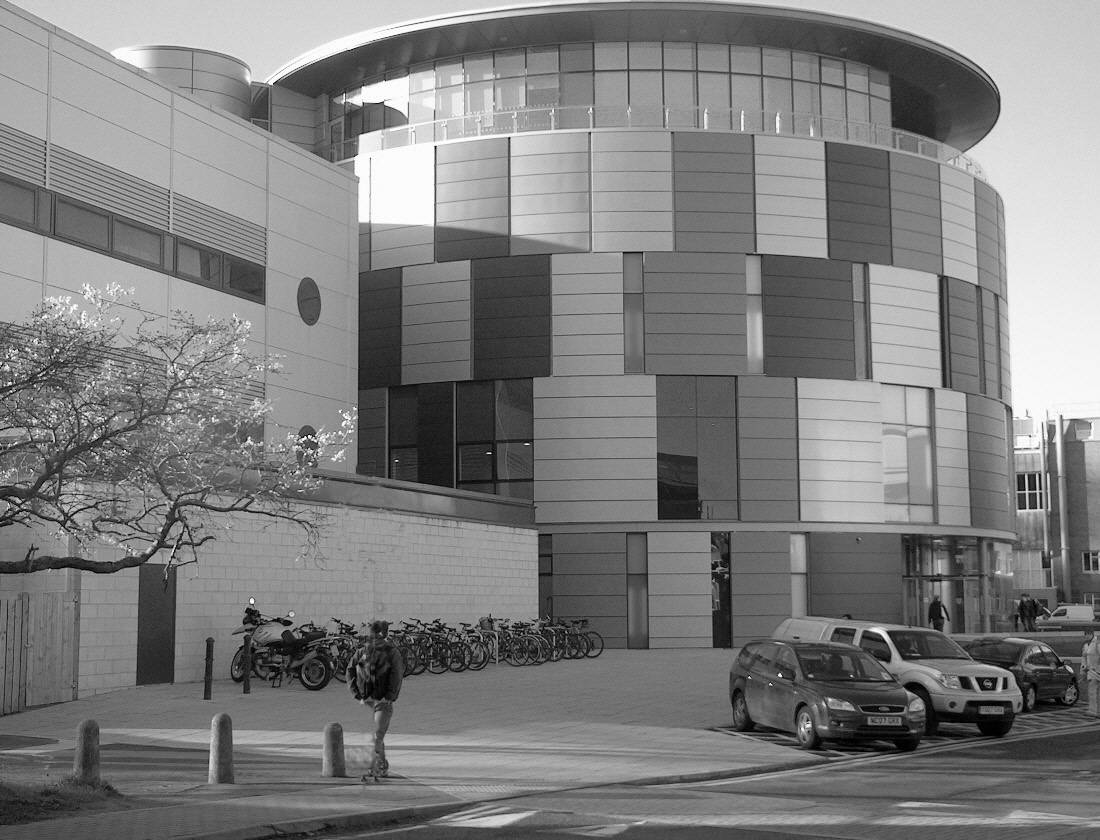The City of Durham Trust
Architectural Award 2007

Calman Learning Centre - from the south-east (D.Jones)
Unconventional or modern architecture in Durham has to be both in the appropriate location and of the highest standard in order to gain acceptance in our historic city. The University achieved this with Dunelm House, which guards the river gorge and forms a single composition with Kingsgate Bridge. This year the Calman Learning Centre, on the University’s Science Site, has passed the same test and is well deserving of the Trust’s award.
The prominent four-storey building is the focus, not only for the recent Earth Sciences building, from which it springs, but for the whole of the Science Site. In fact, it can be said to preside less over the Science Site than over Science City, for it is a place-making structure, one which creates its own context.
The design is at once both simple yet sophisticated, striking by day, stunning at night. Its innovative round façade of zinc panelling and coloured glazing of varying width stands in contrast to its surrounding neighbours, which are conventionally rectilinear and brick- built. On the top floor the panelling gives way to full glazing, with a surrounding outside verandah sheltered by the circular protruding flat roof. From the verandah is a view of the cathedral comparable to that seen from Mount Joy – if one can avert the eye from straying downwards to the tangle of pipes and flues on the laboratory roofs in the near foreground. Immediately below, however, in front of the building commendable attention has been paid to paved routes and landscaping.
Inside, the round structure lends itself to a series of tiered lecture theatres, the largest seating 400, each named after a distinguished University scholar. Appropriately for the Science Site, also, are the suites of computer terminals – and a ‘technocrat café.’
The impressive structure emanates from Building Design Partnership, winners of the University competition in 2005. Within BDP the design credit belongs initially to John McManus, director of architecture in their Glasgow office. All other aspects were shared by BDP offices. The contractors were Laing O’Rourke of Newcastle, with John Osborne the project manager.
The Clubhouse of Durham Amateur Rowing Club
This, at the end of Green Lane, is a second building which has added positively to the architectural stock of the City. Although more capacious than the original clubhouse, which it replaced, an imposed condition was that it retained a similar profile. Its architects, Jane Darbyshire and David Kendall, may have designed with more panache elsewhere, but here, in a sylvan setting, it is entirely appropriate. Low and compact, with a monopitch roof, a prominent round window by the entrance alludes to its water or nautical connection. It was built by Dorin Construction, with BDN the lead consultants.
Inside, besides changing rooms, gymnasium and fitness centre and, of course bar and facility room, is an IT suite. The last-named is connected with outreach to schools, part of the government’s ‘Playing for Success’ scheme, and indicative of the Club’s wider role in the community. The whole project was aided by funds from various sources, including the Lottery and Sport England.
Hawthorn House
This a new respite/short break centre at Newton Hall for adults with learning difficulties, is an exemplary example of interior behavioural design. The architect, Ian Scott (of Nixon Architects, Darlington), working collaboratively with the staff, has produced an environment appreciated by all. It is not too much to say that, throughout, there is a pervading atmosphere of a welcoming hotel – light and warmth, en suite units, fittings and furnishings. Nothing could be more removed from the original Hawthorn House in Pity Me, which it replaces.
It is a County Council project, funded through the sale of the former Pity Me premises. Perhaps the limited budget explains the generally disappointing external appearance. The minimalist projecting metal canopy at the entrance, not least, is an opportunity lost to signal arrival at somewhere exciting.
